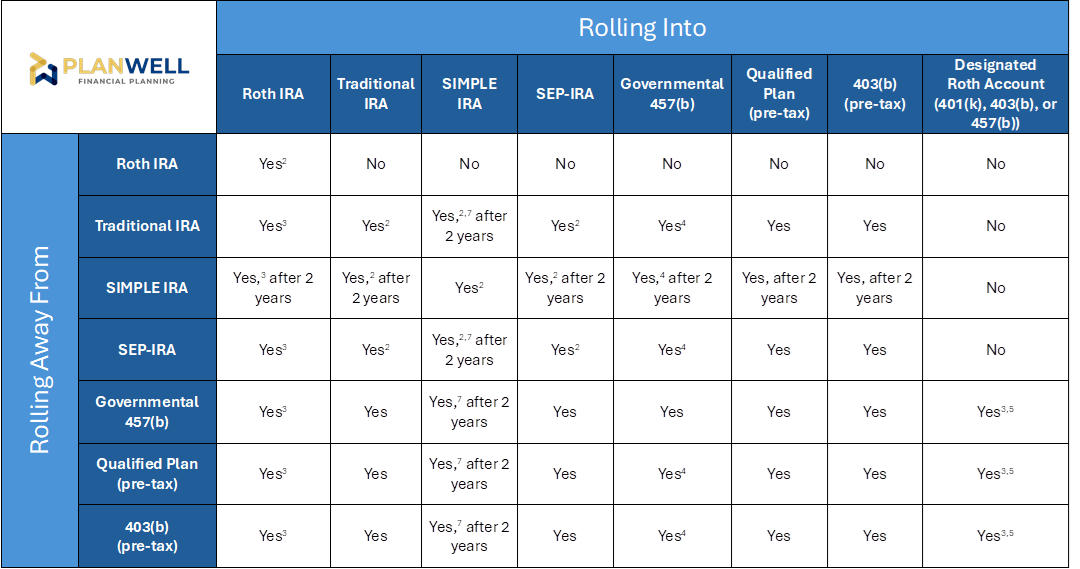
(1) Qualified plans include, for example, profit-sharing, 401(k), money purchase, and defined benefit plans.
(2) Only one rollover in any 12-month period.
(3) Must include in income.
(4) Must have separate accounts.
(5) Must be an in-plan rollover.
(6) Any nontaxable amounts distributed must be rolled over by direct trustee-to-trustee transfer.
(7) Applies to rollover contributions after December 18, 2015.
Maximizing Your Retirement Savings: The Benefits of Rollover IRAs and 401(k) Options
Planning for retirement is a significant aspect of financial well-being, and understanding the various retirement savings options available can make a substantial difference in one’s future comfort and security. Among these options, Rollover Individual Retirement Accounts (IRAs) and 401(k) plans play critical roles. This article explores the ins and outs of Rollover IRAs, the process of rolling over a 401(k) into a new IRA, the unique advantages of switching to a Roth IRA, navigating the complexities involved in retirement account rollovers, and a look into the investment opportunities these accounts offer. Here, the benefits and essential considerations surrounding these retirement plan options will be thoroughly discussed to empower individuals to maximize their retirement savings effectively.
What is a Rollover IRA and How Does it Compare to a Traditional IRA?
Understanding the Basics of a Rollover IRA
A Rollover IRA is a type of Individual Retirement Account that allows individuals to transfer funds from an employer-sponsored retirement plan, like a 401(k), into an IRA without incurring early withdrawal penalties. This process of moving your retirement assets is crucial for maintaining the tax-advantaged status of these savings. A rollover IRA serves as a bridge, enabling the consolidation of various retirement accounts into one, streamline management, and potentially broaden the range of investment options beyond what employer-sponsored plans typically offer.
Comparing Traditional IRAs and Rollover IRAs
While traditional IRAs and rollover IRAs share many features, including their tax-advantaged growth potential, there are distinct differences. Traditional IRAs allow individuals to contribute money that may be tax-deductible, growing tax-deferred until withdrawals begin, which are then taxed as income. On the other hand, a rollover IRA primarily receives funds from other retirement plans. The original tax treatment of the rolled-over money—pre-tax or after-tax—continues in the rollover IRA, blending the attributes of the contributing account and preserving its tax benefits.
The Tax Implications of Rollover vs. Traditional IRAs
The tax implications of traditional and rollover IRAs are pivotal in retirement planning. Traditional IRA contributions may lower your taxable income in the year they’re made, potentially deferring taxes until retirement. Conversely, while the IRA rollover process itself does not trigger a tax event, the type of IRA you choose for your rollover (Traditional or Roth) influences how these funds are taxed upon withdrawal. Opting for a rollover into a Roth IRA, for example, involves paying taxes upfront but provides tax-free withdrawals in retirement, a critical aspect for future financial planning.
How to Roll Over Your Old 401(k) into a New IRA
The Steps Involved in the Rollover Process
Rolling over an old 401(k) into a new IRA involves a few key steps. First, decide whether a traditional IRA or a Roth IRA best suits your financial situation. Once you’ve made this decision, you will need to open an appropriate IRA account with a chosen financial institution. Contacting your current 401(k) plan administrator to initiate the rollover comes next. Most institutions offer direct rollover options, where the transfer of funds occurs between the financial institutions without the money ever passing through your hands, avoiding any risk of incurring early withdrawal penalties. If you’d like more in-depth information, see Rolling Over an Old Work Retirement Plan? Here’s What You Need to Know.
Avoiding Penalties During the Rollover
To ensure the rollover of your retirement savings does not attract penalties, opting for a direct rollover is advisable. In instances where an indirect rollover is chosen—where the check is made payable to you—it is critical to deposit the full amount into your new IRA within 60 days to avoid taxes and early withdrawal penalties. Understanding these details is vital in planning a smooth transition of your retirement assets.
Choosing Between a Direct Rollover and an Indirect Rollover
The choice between a direct and an indirect rollover depends on individual circumstances and preferences. While a direct rollover is straightforward and typically used to avoid penalties and taxes, an indirect rollover offers the account holder short-term access to the funds. However, this comes with the responsibility of ensuring the money is deposited into a new retirement account within 60 days to evade penalties. Each option has its intricacies and potential implications for your retirement savings.
Benefits of Rolling Over to a Roth IRA
Tax-Free Growth Potential of Roth IRAs
One of the most significant advantages of a Roth IRA is its tax-free growth potential. Unlike traditional IRAs, where contributions are tax-deductible, and withdrawals are taxed, Roth IRAs offer the benefit of tax-free withdrawals in retirement, provided certain conditions are met. This can be especially beneficial for those who expect to be in a higher tax bracket during retirement, making tax planning an essential factor in choosing to roll over into a Roth IRA.
Understanding the Conversion Process from Traditional IRA to Roth IRA
The conversion process from a traditional IRA or a rollover IRA to a Roth IRA involves transferring your pre-tax retirement assets into a Roth account, subjecting them to taxation at your current rate. This strategic move can offer long-term tax benefits, particularly for individuals who anticipate higher tax rates in the future. The process requires careful consideration of current tax liabilities versus future savings, underlining the importance of tax planning in retirement strategies.
Eligibility Criteria for Roth IRA Rollovers
Understanding the eligibility criteria for Roth IRA rollovers is essential. While there are income limits for contributing directly to a Roth IRA, these limits do not apply to converting a traditional IRA to a Roth IRA. This makes the Roth conversion an attractive option for higher-income earners seeking the tax-free benefits of a Roth IRA. However, the converted amount is considered taxable income in the year of the conversion, making careful timing and tax planning crucial to maximize benefits.
Navigating the Complexities of Retirement Account Rollovers
How to Handle the 60-Day Rollover Rule
The 60-Day Rollover Rule is an IRS regulation that allows for the temporary use of retirement funds for up to 60 days. When performing an indirect rollover, the funds must be re-deposited into a qualifying retirement plan or IRA within 60 days to avoid taxation and penalties. Understanding and adhering to this rule is crucial for individuals executing an indirect rollover, highlighting the importance of planning and timing in the rollover process.
Common Pitfalls in the Rollover Process and How to Avoid Them
Common pitfalls in the rollover process include missing the 60-day window for indirect rollovers, inadvertently violating IRS rules on rollovers, and choosing investment options that do not align with long-term retirement goals. To avoid these pitfalls, it’s advised to opt for direct rollovers when possible, stay informed about IRS regulations, and carefully consider the investment options within your new IRA, seeking the advice of a financial advisor when necessary.
When to Consult a Financial Planner During the Rollover Process
Consulting with a Financial Planner during the rollover process can provide invaluable guidance and peace of mind. If you are a federal employee or retiree, consider working with a financial advisor for federal employees who specializes in the intricacies of government benefits and retirement systems. They can help navigate the complexities of rollover options, tax implications, and investment choices, ensuring that your retirement savings are optimized for your future needs. Particularly for individuals facing complicated financial situations or major life changes, seeking professional advice can be a crucial step in securing a stable and prosperous retirement.
Exploring Investment Options with New IRA Accounts
The Role of Index Funds in Your Retirement Plan
Index funds play a significant role in retirement planning, offering a diversified portfolio within a single investment. For new IRA accounts, including those funded through rollovers, index funds can provide a balance of stocks, bonds, and other securities, potentially spreading risk and enhancing returns over time. Understanding the different types of mutual funds and their respective risk and return profiles is essential in selecting the right investments for your retirement plan.
IRA Contribution Limits and How They Affect Your Rollover
IRA contribution limits, which the IRS sets annually, are an important consideration in retirement planning. These limits do not affect the amount you can roll over from an employer-sponsored plan to an IRA. However, they do apply to any new contributions to your rolled-over IRA. Being aware of these limits is crucial in planning your annual contributions and ensuring that your retirement savings strategy remains on track.
Reach Out to Us!
If you have additional federal benefit questions, reach out to our team of CERTIFIED FINANCIAL PLANNER™ (CFP®), Accredited Investment Fiduciary (AIF®), and Chartered Federal Employee Benefits Consultants (ChFEBC℠). At PlanWell, we focus on retirement planning for federal employees. Learn more about our process designed for the career federal employee.
Preparing for a federal retirement? Check out our scheduled federal retirement workshops. Sign up for our no-cost federal retirement webinars. Make sure to plan ahead and reserve your seat for our FERS webinar, held every three weeks. Want to have PlanWell host a federal retirement seminar for your agency? Reach out and we’ll collaborate with HR to arrange an on-site FERS seminar.
Want to fast track your federal retirement plan? Skip the FERS webinar and start a one-on-one conversation with a ChFEBC today. You can schedule a one-on-one meeting to get personalized guidance.










